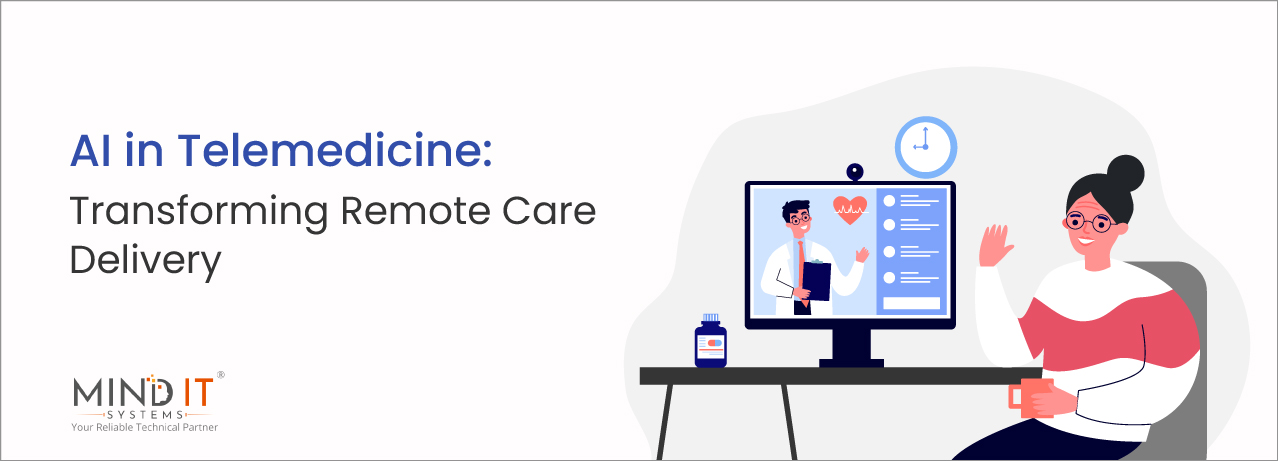
AI in Telemedicine: Transforming Remote Care Delivery
Introduction
AI in telemedicine is transforming the healthcare landscape, enhancing remote patient care and optimizing clinical workflows. With the integration of Artificial Intelligence in telemedicine, healthcare providers can leverage AI-powered tools for diagnostics, patient monitoring, and data security, significantly improving efficiency and accessibility.
This article will explore the impact of Artificial Intelligence in telemedicine, including its applications, benefits, challenges, and the future outlook.
So, join us to discover.
Table of Contents
The Rise of AI in Telemedicine
Telemedicine has seen unprecedented growth, particularly during the COVID-19 pandemic. According to the Centers for Disease Control and Prevention (CDC), AI in telemedicine usage in the United States increased by over 154% during the pandemic’s peak in 2020. The Global AI in Telemedicine Market, valued at $97.15 billion in 2023, is expected to reach $432.31 billion by 2032, growing at a CAGR of 19.0%, as per Fortune Business Insights. This growth reflects a fundamental shift in healthcare delivery, driven by AI’s ability to streamline processes and enhance patient care.
Transform Healthcare with AI!
Leverage our expertise in AI-driven telemedicine solutions to enhance patient care and operational efficiency.
How AI in Telemedicine Enhances Remote Healthcare?
The implementation of AI in telemedicine is revolutionizing remote healthcare by improving diagnostics, remote patient monitoring, and virtual assistance. These advancements enable healthcare providers to deliver timely and accurate medical services without geographical limitations, ultimately making remote healthcare more effective and accessible.
#1 AI-Powered Virtual Assistants in Healthcare
AI-powered chatbots and virtual assistants streamline AI in telemedicine by managing patient inquiries, scheduling appointments, and offering preliminary diagnostic advice. According to Forrester Research, over 30% of AI-driven telemedicine visits in the U.S. incorporate virtual assistants, reducing administrative burdens and improving patient experience.
These intelligent bots help patients navigate healthcare services efficiently, improving response times and overall satisfaction. AI-powered chatbots can assess symptoms, suggest possible conditions, and escalate serious cases to human professionals, ensuring timely medical intervention.
#2 Remote Patient Monitoring (RPM) with AI
AI in telemedicine enhances remote patient monitoring by leveraging AI-powered wearables and sensors for real-time health tracking. Grand View Research reports that the RPM market is expected to reach $117.1 billion by 2025, driven largely by AI technologies that continuously analyze patient data.
Devices like smartwatches and health trackers monitor vital signs such as heart rate and blood pressure, allowing AI to detect early warning signs and assist healthcare providers in timely interventions. These advancements are crucial in managing chronic conditions and preventing health crises. By continuously tracking a patient’s health, AI-enabled RPM solutions can alert doctors about deviations from normal parameters, leading to proactive healthcare management.
#3 AI-Based Diagnostics for Enhanced Accuracy
AI-driven diagnostics in telemedicine improve the accuracy and efficiency of medical assessments. From medical imaging to lab test interpretations, AI supports healthcare professionals in delivering precise results. Platforms like Aidoc, an AI-powered radiology tool, assist doctors in identifying conditions such as brain hemorrhages with 95% diagnostic accuracy.
A study in The Lancet Digital Health found that AI-based algorithms outperform radiologists in detecting breast cancer, reducing false positives by 10-15%. This improvement in diagnostic precision leads to faster, more accurate treatments and better patient outcomes. AI-based diagnostics minimize human errors and enable healthcare professionals to diagnose illnesses more effectively.
#4 Mental Health Support Through AI
AI in telemedicine plays a crucial role in mental health services by providing virtual therapy, mood tracking, and crisis intervention. AI-driven platforms such as Woebot and Wysa offer cognitive behavioural therapy (CBT) techniques, helping individuals manage stress, anxiety, and depression.
According to the World Health Organization, AI-based mental health solutions increased engagement by 40% during the pandemic, demonstrating their effectiveness in psychological support. These tools make mental health resources more accessible and personalized, addressing the growing demand for mental wellness services. AI-driven mental health applications analyze speech patterns, facial expressions, and biometric data to provide real-time emotional assessments and therapy recommendations.
#5 AI Solutions for Chronic Disease Management
Chronic diseases such as diabetes and hypertension require continuous monitoring, and AI-powered telemedicine solutions are revolutionizing care management. AI-enabled platforms analyze blood sugar levels, medication adherence, and lifestyle habits, providing real-time feedback to patients and healthcare providers.
The National Institute of Health reports that AI-powered chronic disease management tools reduce hospitalization rates by 30%, making AI an indispensable asset in long-term healthcare. By integrating AI-driven insights into daily patient routines, healthcare providers can offer more proactive and effective treatment plans. AI-powered analytics help detect patterns in chronic disease patients, enabling predictive healthcare and reducing emergency interventions.
Unlock AI’s Potential in Telemedicine!
Get a free consultation with our AI experts to explore innovative solutions for remote healthcare.
Key Benefits of AI-Driven Telemedicine
Integrating AI in telemedicine provides significant advantages that benefit both healthcare providers and patients.
#1 Increased Accessibility and Convenience
AI removes geographic barriers, making specialist care more accessible to remote and underserved populations. Health Affairs reported a 38% rise in AI-enabled telemedicine consultations, showcasing its growing significance.
Patients who previously struggled with limited healthcare access can now receive quality medical advice and treatment through virtual consultations. AI-driven systems match patients with the right specialists, ensuring personalized care regardless of location.
#2 Cost-Effectiveness and Resource Optimization
AI in telemedicine reduces healthcare costs by minimizing in-person visits and hospital stays. McKinsey & Company estimates that AI-driven telemedicine could save up to $250 billion annually in the U.S. healthcare system by shifting 20% of in-person visits to telehealth. This cost reduction benefits both healthcare providers and patients, leading to more efficient resource allocation and lower medical expenses. AI-powered automation also reduces administrative overhead, cutting down paperwork and streamlining billing processes.
#3 Enhanced Patient Engagement and Personalized Care
AI in telemedicine enables personalized health recommendations, medication reminders, and wellness plans, increasing patient adherence to treatments. Deloitte found that 61% of patients are more likely to follow treatment plans when AI-powered health management tools are involved.
Engaging patients in their own care fosters better health outcomes and encourages a proactive approach to wellness. AI-driven virtual health coaches guide patients in making informed health choices, ensuring continuous engagement in their treatment plans.
#4 Strengthened Data Security Measures
AI in telemedicine ensures the protection of sensitive patient information through encryption, blockchain integration, and anomaly detection in cybersecurity. The Healthcare Information and Management Systems Society (HIMSS) states that AI-powered security systems prevent over 90% of potential cyber threats in telehealth platforms, ensuring safe data transmission and storage.
As healthcare digitization increases, maintaining robust security protocols is essential in safeguarding patient data. AI-powered cybersecurity solutions constantly monitor network activity, detecting and preventing unauthorized access to patient records.
Challenges of AI in Telemedicine
Despite its advantages, AI in telemedicine faces several challenges:
- Data Privacy Concerns – Ensuring patient data security and compliance with regulations such as HIPAA remains a significant challenge.
- Regulatory and Ethical Issues – AI implementation in healthcare must adhere to strict policies and ethical considerations to prevent bias and errors.
- Limited Technological Infrastructure – Not all healthcare facilities have the necessary AI infrastructure, leading to disparities in AI adoption.
- Patient Trust and Acceptance – Many patients are hesitant to rely on AI-driven healthcare solutions due to concerns about accuracy and reliability.
- Integration with Existing Systems – AI solutions must be seamlessly integrated with current healthcare IT systems, which can be complex and resource-intensive.
Partnering with an experienced healthcare software development company which has a proven track record in AI-driven healthcare solutions, can help overcome these challenges.
Future of AI in Telemedicine
The role of AI in healthcare is expanding rapidly, with advancements in predictive analytics, real-time diagnostics, and autonomous health monitoring. As AI algorithms evolve, they will enhance precision, personalize treatments, and improve healthcare accessibility, ensuring a smarter and more efficient telehealth ecosystem.
Let’s Discuss Your AI-Powered Healthcare Solution!
Connect with our team to explore customized AI solutions for telemedicine.
Share this post
About the Author

Sujoy Roy
(Head – Digital Marketing)
From my teenage time, I had a quench to solve problems and loved leadership. Starting my career in relation management, ignited my passion for managing people. While managing I realized technology needs to be incorporated to keep pace with the changing world & do my work efficiently.

